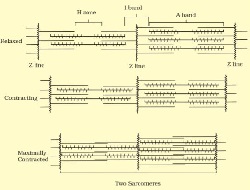
myCBSEguide App
Download the app to get CBSE Sample Papers 2023-24, NCERT Solutions (Revised), Most Important Questions, Previous Year Question Bank, Mock Tests, and Detailed Notes.
Install NowCBSE Biology Chapter 20 Locomotion and Movement class 11 Notes Biology in PDF are available for free download in myCBSEguide mobile app. The best app for CBSE students now provides Locomotion and Movement class 11 Notes Biology latest chapter wise notes for quick preparation of CBSE exams and school based annual examinations. Class 11 Biology notes on Chapter 20 Locomotion and Movement class 11 Notes Biology are also available for download in CBSE Guide website
Locomotion and Movement class 11 Notes Biology
Download CBSE class 11th revision notes for Chapter 20 Locomotion and Movement class 11 Notes Biology in PDF format for free. Download revision notes for Locomotion and Movement class 11 Notes Biology and score high in exams. These are the Locomotion and Movement class 11 Notes Biology prepared by team of expert teachers. The revision notes help you revise the whole chapter in minutes. Revising notes in exam days is on of the best tips recommended by teachers during exam days.
Revision Notes for Class 11 Biology Download as PDF
CBSE Quick Revision Notes CBSE Class 11 Biology Chapter 20 Locomotion and Movement
Locomotion is the voluntary movement of an individual from one place to another. Walking, running, climbing, swimming are the examples of locomotion. All locomotion are movement but all movements are not locomotion.
Types of Movement
Cells of the human body show three main types of movements:

- Macrophages and leucocytes in blood exhibit amoeboid movements. Coordinated movement of cilia in trachea to remove dusts particles and passage of ova through fallopian tube is example of Ciliary movements.
- Movement of limbs, jaw, tongue, etc. need muscular movement. Contractile property of muscles is used in movement in higher organism including human beings.
Muscles are specialized tissues of mesodermal origin. They have property like excitability, contractility, extensibility and elasticity.
Based on their location, three types of muscles are identified

| Skeletal Muscles | Visceral Muscles | Cardiac Muscles |
| Associated with skeletal system, alternate light and dark bands (striated), voluntary and locomotory and change in body posture function. | Form inner wall of internal visceral organs, non-striated, involuntary muscle, assists in movement of food through digestive tract and gametes. | Muscles of heart, having branching pattern, alternate light and dark bands, involuntary in action. |
- Skeletal Muscle is made up of muscles bundles (fascicles), held together by collagenous connective tissue called fascia.
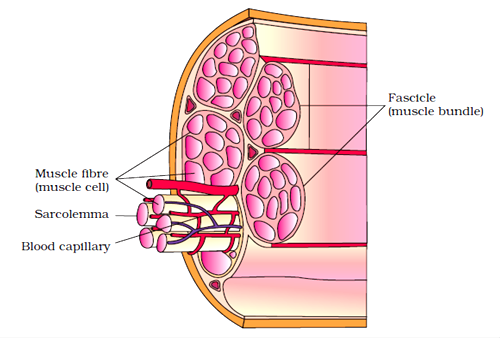
- Each muscle bundle contains a number of muscle fibres. Each muscle fibre is lined by plasma membrane called sarcolemma enclosing sarcoplasm. Partially arranged myofibrils are present in muscle bundle having alternate light and dark bands due to presence of protein- actin and myosin
- Light bands contain actin and is called I-band (isotropic band) and dark band contains myosin, called A-band (anisotropic band). Both bands are present parallel to each other in longitudinal fashion.
- In centre of each I-band is elastic fibre called ‘Z’ line. In the middle of A-band is thin fibrous ‘M’ line. The portion of myofibrils between two successive ‘Z’ lines is the functional unit of contraction called a sarcomere.
- At resting stage thin filament overlaps the thick filament. The part of thick filament not overlapped is called ‘H’ zone.
Structure of contractile Protein
Each thin filament (actin) is made of two ‘F’ actins helically wounded to each other. Two filaments of another protein, tropomyosin runs close to it. A complex protein
Troponin is distributed at regular intervals on the tropomyosin.

Each myosin filament is made of many monomeric proteins called Meromyosins. Each meromyosin has globular head with short arm and tails. Globular head has ATP binding sites.
Mechanism of muscle contraction
- The mechanism of muscle contraction is explained by sliding mechanism theory in which thin filament slide over thick filament.
- Muscle contraction start with signal sent by CNS via motor neuron. Neural signal release neurotransmitter ( Acetyl choline) to generate action potential in the sarcolemma.
- This causes the release of Ca ++ from sarcoplasmic reticulum.
- Ca ++ activates actin which binds to the myosin head to form a cross bridge.
- These cross bridges pull the actin filaments causing them to slide over the myosin filaments and thereby causing contraction.
- Ca ++ are then returned to sarcoplasmic reticulum which inactivate the actin. Cross bridges are broken and the muscles relax.
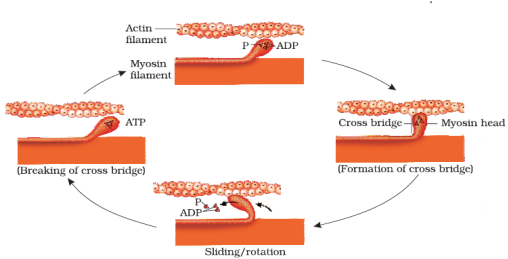
Muscles are classified as:
Red fibres (aerobic muscles-) contain myoglobin that has plenty of mitochondria to use large amount of oxygen stored in them.
White fibres-the muscle fibres containing less number of myoglobin are called white fibres.
Skeletal System
Framework of bones and cartilage forms the skeletal system. In human beings, it consists of 206 bones and some cartilages. The two principle division of skeletal system are:
- Axial Skeleton (80 bones)- includes skull, vertebral column, sternum and ribs constitute axial system.
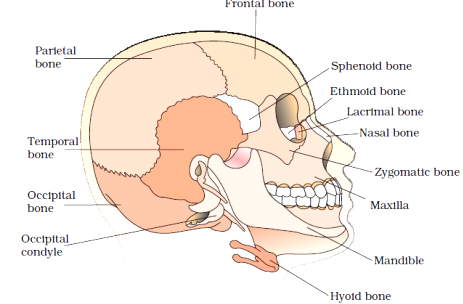
- The skull (22 bones) is composed of cranial and facial bones. Cranial (8 bones) forms protective covering for brain (cranium). The facial region consists of 14 skeletal systems that form front part of skull. Hyoid bone (U-shaped) forms the base of buccal cavity.
- The middle ear bone (Malleus, Incus and Stapes) collectively called Ear Ossicles. Skull joins with vertebral column with two occipital condyle.
- Vertebral column consists of 26 serially arranged vertebrae. First vertebra is atlas that combines with occipital condyle. Other includes Cervical-7, thoracic -12, lumbar -5, sacral – 1 coccoygeal -1.
- 12 pairs of ribs connected dorsally to vertebral column and ventrally to sternum. 11th and 12th rib bones are not connected with sternum and are called floating ribs.
Appendicular Skeleton- includes bones of limbs and girdles. Each limb contains 30 bones.
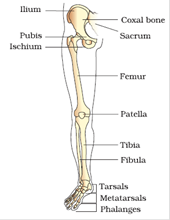
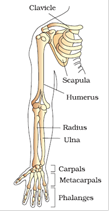
| Upper Arm | Lower Limb |
| Humerus, radius and ulna, 8-carpels, 5-metacarpels, 14-phalanges, | Femur, tibia and fibula, 7-tarsals, 5-metatarsals, 14-phalanges, cup shaped patella cover the knee. |
Pectoral and Pelvic girdle bones help in the articulation of the upper and the lower limbs
respectively with the axial skeleton.
Pectoral girdle consists of a clavicle and a scapula.
Pelvic girdle consists of two coxal bones. Each coxal bone is formed by the fusion of three bones – ilium, ischium and pubis.
Joints – are points of contact between bones, or between bones and cartilage.
- Fibrous joints– do not allow any movements. Present in flat skull bones to form cranium.
- Cartilaginous joints– bones are held together with the help of cartilage present in vertebrae. Permits limited movements.
- Synovial joints– fluid filled synovial cavity, provide considerable movements. Ball and socket joint, hinge joints, pivot joints, gliding joints etc.
Disorders of Muscular and Skeletal System
- Myasthenia gravis- auto immune disorder affecting neuromuscular junction causing fatigue, weakening and paralysis of skeletal system.
- Muscular Dystrophy- degeneration of skeletal muscles due to genetic disorder.
- Osteoporosis – decreased bone mass in old age leading to chance of fracture due to decreased estrogen.
- Arthritis- inflammation of joints.
- Gout- inflammation of joints due to accumulation of uric acid crystals.
- Tetany- Rapid spasms in muscle due to low Ca ++ in body fluid
Locomotion and Movement class 11 Notes Biology
CBSE quick revision note for class 11 Mathematics, Physics, Chemistry, Biology and other subject are very helpful to revise the whole syllabus during exam days. The revision notes covers all important formulas and concepts given in the chapter. Even if you wish to have an overview of a chapter, quick revision notes are here to do if for you. These notes will certainly save your time during stressful exam days.
- Physics
- Chemistry
- Mathematics
- Biology
- Accountancy
- Economics
- Business Studies
- Computer Science
- Informatics Practices
- Geography
To download Locomotion and Movement class 11 Notes, sample paper for class 11 Chemistry, Physics, Biology, History, Political Science, Economics, Geography, Computer Science, Home Science, Accountancy, Business Studies and Home Science; do check myCBSEguide app or website. myCBSEguide provides sample papers with solution, test papers for chapter-wise practice, NCERT solutions, NCERT Exemplar solutions, quick revision notes for ready reference, CBSE guess papers and CBSE important question papers. Sample Paper all are made available through the best app for CBSE students and myCBSEguide website.
- The Living World class 11 Notes Biology
- Biological Classification class 11 Notes Biology
- Plant Kingdom class 11 Notes Biology
- Animal Kingdom class 11 Notes Biology
- Morphology of Flowering Plants class 11 Notes Biology
- Anatomy of Flowering Plants class 11 Notes Biology
- Structural Organisation in Animals class 11 Notes Biology
- Cell Structure and Functions class 11 Notes Biology
- Biomolecules class 11 Notes Biology
- Cell Cycle and Cell Division class 11 Notes Biology
- Transport in Plants class 11 Notes Biology
- Mineral Nutrition class 11 Notes Biology
- Photosynthesis in higher plants class 11 Notes Biology
- Respiration in Plants class 11 Notes Biology
- Plant Growth and Development class 11 Notes Biology
- Digestion And Absorption class 11 Notes Biology
- Breathing and Exchange of Gases class 11 Notes Biology
- Body Fluids And Circulation class 11 Notes Biology
- Excretory Products and their Elimination class 11 Notes Biology
- Neural Control and Coordination class 11 Notes Biology
- Chemical Coordination and Integration class 11 Notes Biology
- Cell Structure and Functions class 11 Notes Biology

Test Generator
Create question paper PDF and online tests with your own name & logo in minutes.
Create Now
myCBSEguide
Question Bank, Mock Tests, Exam Papers, NCERT Solutions, Sample Papers, Notes
Install Now